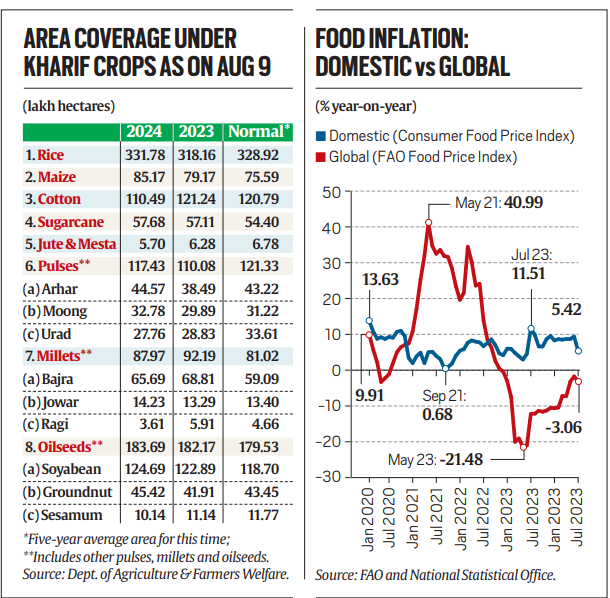Retail Food Inflation Drops Sharply to 5.4% in July, But Uncertainty Persists
(Source: Indian Express; Section: Explained; Page: 07)
| Topic: GS3 – Indian Economy – |
| Context: |
|
Analysis of News:

What is Inflation?
-
- Inflation refers to the overall increase in the prices of goods and services, coupled with a decrease in people’s purchasing power.
-
- This means that when inflation rises (without an equivalent rise in your income), you are able to buy fewer things than you could buy previously, or you have to pay more money for the same stuff now.
-
- A “rising” inflation rate implies that the rate (at which the prices rise) itself is increasing.
-
- For example, if the inflation rate was 1% in March, 2% in April, 4% in May, and 7% in June, it shows a continuous acceleration in the rate of price increases.
What are the Different Indices through Which Food Inflation is Measured in India?
- Consumer Price Index (CPI):
-
- CPI inflation, also known as retail inflation, is the rate at which the prices of goods and services that consumers buy for personal use increase over time.
-
- It measures the change in the cost of a basket of goods and services that are typically purchased by households, including food, clothing, housing, transportation, and medical care, and are of four types:
-
-
- CPI for Industrial Workers (IW).
-
-
-
- CPI for Agricultural Labourer (AL).
-
-
-
- CPI for Rural Labourer (RL).
-
-
-
- CPI for Urban Non-Manual Employees (UNME).
-
- Consumer Food Price Inflation (CFPI):
-
- CFPI is a component of the broader Consumer Price Index (CPI), where the Reserve Bank of India (RBI) utilises the CPI-Combined (CPI-C) for this purpose.
-
- cCFPI monitors the price fluctuations of a particular selection of food items commonly consumed by households, including cereals, vegetables, fruits, dairy products, meat, and other essential food staples.
-
- CFPI is a component of the broader Consumer Price Index (CPI), where the Reserve Bank of India (RBI) utilises the CPI-Combined (CPI-C) for this purpose.
- The Wholesale Price Index (WPI):
-
- It tracks changes in the prices of goods sold and traded in bulk by wholesale businesses to other businesses and it specifically focuses on goods, services are not part of it.
-
- The WPI is utilized to monitor supply and demand dynamics in industries, manufacturing, and construction sectors.
-
- Released monthly by the Economic Advisor in the Ministry of Commerce and Industry, the index measures the level of wholesale inflation in the economy based on the month-to-month increase in WPI, and it comprises various component
-
- Primary articles, constituting 22.62% of the Wholesale Price Index (WPI), are divided into Food Articles and Non-Food Articles.
-
-
- Food Articles encompass items like Cereals, Paddy, Wheat, Pulses, Vegetables, Fruits, Milk, Eggs, Meat, and Fish.
-
-
-
- Non-Food Articles include Oil Seeds, Minerals, and Crude Petroleum.
-
Impact on Economy: Despite the decline, food inflation remains a significant concern, limiting household spending and preventing the Reserve Bank of India from reducing interest rates.
Monsoon Influence: The southwest monsoon revived after a weak start in June, leading to above-normal rainfall in July and August. This improved water availability has led to increased acreage for key crops like rice, pulses, maize, oilseeds, and sugarcane.
Global Food Prices: Global food prices have decreased since December 2022, helping to mitigate domestic inflation. Lower international prices for commodities like wheat make imports more feasible, potentially easing domestic prices.
Cautious Optimism: While the good monsoon and potential La Niña conditions are positive, the full impact on food inflation will only be clear after the upcoming harvests. Uncertainty remains, especially with the harvest still weeks away.
| What are the Strategies that Need to be Adopted to Tackle Food Inflation in India? |
Improved Supply Chain Management:
Agricultural Productivity Enhancement:
Price Monitoring and Regulation:
Agricultural Diversification:
Climate Resilience:
Utilizing technology:
|
| PYQ: There is also a point of view that agriculture produce market committees (APMCs) set up under the state acts have not only impeded the development of agriculture but also have been the cause of food inflation in India. Critically examine. (200 words/12.5m) (UPSC CSE (M) GS-3 2014) |
| Practice Question: Examine the recent trends in retail food inflation in India and discuss the factors influencing it. How can government policies mitigate the impact of food inflation on the economy and households? (250 words/15 m) |
